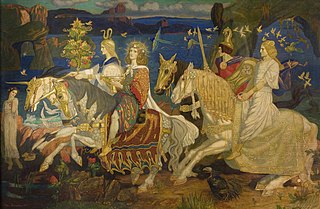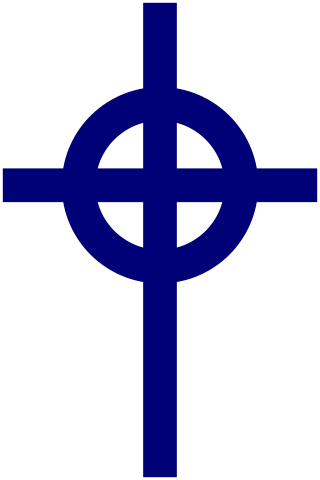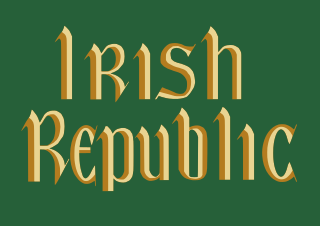
Irish mythology is the body of myths native to the island of Ireland. It was originally passed down orally in the prehistoric era, being part of ancient Celtic religion. Many myths were later written down in the early medieval era by Christian scribes, who modified and Christianized them to some extent. This body of myths is the largest and best preserved of all the branches of Celtic mythology. The tales and themes continued to be developed over time, and the oral tradition continued in Irish folklore alongside the written tradition, but the main themes and characters remained largely consistent.

Fionn mac Cumhaill, often anglicized Finn McCool or MacCool, is a hero in Irish mythology, as well as in later Scottish and Manx folklore. He is the leader of the Fianna bands of young roving hunter-warriors, as well as being a seer and poet. He is said to have a magic thumb that bestows him with great wisdom. He is often depicted hunting with his hounds Bran and Sceólang, and fighting with his spear and sword. The tales of Fionn and his fiann form the Fianna Cycle or Fenian Cycle, much of it narrated by Fionn's son, the poet Oisín.

Fianna were small warrior-hunter bands in Gaelic Ireland during the Iron Age and early Middle Ages. A fian was made up of freeborn young males, often from the Gaelic nobility of Ireland, "who had left fosterage but had not yet inherited the property needed to settle down as full landowning members of the túath". For most of the year they lived in the wild, hunting, cattle raiding other Irish clans, training, and fighting as mercenaries. Scholars believe the fian was a rite of passage into manhood, and have linked fianna with similar young warrior bands in other early European cultures.

The Celtic cross is a form of Christian cross featuring a nimbus or ring that emerged in Ireland, France and Great Britain in the Early Middle Ages. A type of ringed cross, it became widespread through its use in the stone high crosses erected across the islands, especially in regions evangelized by Irish missionaries, from the ninth through the 12th centuries.
James, Jimmy or Jim Kelly may refer to:

The Fenian Cycle, Fianna Cycle or Finn Cycle is a body of early Irish literature focusing on the exploits of the mythical hero Finn or Fionn mac Cumhaill and his warrior band the Fianna. Sometimes called the Ossianic Cycle after its narrator Oisín, it is one of the four groupings of Irish mythology along with the Mythological Cycle, the Ulster Cycle, and the Kings' Cycles. Timewise, the Fenian cycle is the third, between the Ulster and Kings' cycles. The cycle also contains stories about other famous Fianna members, including Diarmuid, Caílte, Oisín's son Oscar, and Fionn's rival Goll mac Morna.

Irish republicanism is the political movement for the unity and independence of Ireland under a republic. Irish republicans view British rule in any part of Ireland as inherently illegitimate.

The Fál or Lia Fáil is a stone at the Inauguration Mound on the Hill of Tara in County Meath, Ireland, which served as the coronation stone for the King of Tara and hence High King of Ireland. It is also known as the Stone of Destiny or Speaking Stone. According to legend, all of the kings of Ireland were crowned on the stone up to Muirchertach mac Ercae, c. 500 CE.

Scottish mythology is the collection of myths that have emerged throughout the history of Scotland, sometimes being elaborated upon by successive generations, and at other times being rejected and replaced by other explanatory narratives.
Oscar is a figure in the Fenian Cycle of Irish mythology. He is the son of Oisín and Niamh, and the brother of Plor na mBan, his bride is called Malvina. Though possibly a later addition to the cycle, Oscar was a popular character, and appeared prominently in several later Fenian tales, serving his grandfather as one of the fianna.
Béḃinn or Bé Binn, in modern orthography Béibhinn, is an early Irish personal and mythological name. In some sources Béḃinn is a goddess associated with birth and the sister of the river-goddess, Boann. Béḃinn is also described as being an underworld goddess in both Irish and Welsh mythology, inhabiting either the Irish underworld Mag Mell or the Welsh Annwn, although it is unknown which is the original source.

The Norse–Gaels were a people of mixed Gaelic and Norse ancestry and culture. They emerged in the Viking Age, when Vikings who settled in Ireland and in Scotland became Gaelicised and intermarried with Gaels. The Norse–Gaels dominated much of the Irish Sea and Scottish Sea regions from the 9th to 12th centuries. They founded the Kingdom of the Isles, the Kingdom of Dublin, the Lordship of Galloway, and briefly ruled the Kingdom of York. The most powerful Norse–Gaelic dynasty were the Uí Ímair or House of Ivar.
John O'Leary may refer to:

Acallam na Senórach, is an important prosimetric Middle Irish narrative dating to c. 1200. It is the most important text of the Finn Cycle and at about 8,000 lines is the longest-surviving work of medieval Irish literature. It contains many Finn Cycle narratives framed by a story in which the fianna warriors and Caílte mac Rónáin have survived long enough to relate the tales to Saint Patrick. The work has been seen as a defence of the Irish literary establishment when it came under the scrutiny of Church reformers during the 12th to 13th centuries.
Conán mac Lia is a figure in the Fenian Cycle of Irish mythology. A member of the warrior band the fianna, he is, in a way, less famous than the group's other Conán, Conán mac Morna.

The Pursuit of Diarmuid and Gráinne is an Irish prose narrative surviving in many variants. A tale from the Fianna Cycle of Irish mythology, it concerns a love triangle between the great warrior Fionn mac Cumhaill, the beautiful princess Gráinne, and her paramour Diarmuid Ua Duibhne. Surviving texts are all in Modern Irish and the earliest dates to the 16th century, but some elements of the material date as far back as the 10th century.
The Fenians are a Celtic rock band from Orange County, California. They take their name from a pair of organizations known as the Fenians dedicated to the establishment of an independent Irish Republic in the 19th and early 20th centuries, as well as the Fianna of Irish mythology. Their stated influences include Elvis Costello, U2, The Pogues, and Bob Dylan.

The word Fenian served as an umbrella term for the Irish Republican Brotherhood (IRB) and their affiliate in the United States, the Fenian Brotherhood, secret political organisations in the late 19th and early 20th centuries dedicated to the establishment of an independent Irish Republic. In 1867 they sought to coordinate raids into Canada from the United States with a rising in Ireland. In the 1916 Easter Rising and the 1919–1921 Irish War of Independence, the IRB led the republican struggle.

Celtic mythology is the body of myths belonging to the Celtic peoples. Like other Iron Age Europeans, Celtic peoples followed a polytheistic religion, having many gods and goddesses. The mythologies of continental Celtic peoples, such as the Gauls and Celtiberians, did not survive their conquest by the Roman Empire, the loss of their Celtic languages and their subsequent conversion to Christianity. Only remnants are found in Greco-Roman sources and archaeology. Most surviving Celtic mythology belongs to the Insular Celtic peoples. They preserved some of their myths in oral lore, which were eventually written down by Christian scribes in the Middle Ages. Irish mythology has the largest written body of myths, followed by Welsh mythology.
Failinis [FAW IHN-ish] or Ṡalinnis/Shalinnis is a dog in the Mythological Cycle of Irish literature, belonging to Lugh Lámhfhada of the Tuatha Dé Danann; it was one of the eric (reparation) items exacted from the sons of Tuireann.









